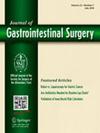尼森底吻合术后食管酸暴露正常化的持久性及其与症状的关系
IF 2.2
3区 医学
Q3 GASTROENTEROLOGY & HEPATOLOGY
引用次数: 0
摘要
nissen底复盖术为胃食管反流病(GERD)患者提供了持久的症状控制。研究还表明,术后1年内远端食管酸暴露正常化率很高。然而,手术后酸暴露正常化的持久性数据是有限的。本研究旨在评估完整尼森底吻合患者的食管酸暴露时间,并确定其持久性相关因素。方法选择在我院行原发性尼森扩底术,经内窥镜检查眼底扩底完整且无疝出的患者。术后1年和4年完成食管pH监测的患者纳入研究。术后平均(SD) 17.7(10)个月进行1年pH监测,术后49.0(26)个月进行4年监测。比较术前、术后1年和4年食管酸暴露程度。根据4年ph监测结果,将1年酸正常化患者分为持久和逐渐正常化组进行比较。食管酸暴露正常化的定义是DeMeester评分为14.7。结果最终研究人群包括71例患者(78.9%为女性),平均(SD)年龄为59.5岁(14岁)。术后1年随访,胃食管反流疾病-健康相关生活质量(GERD-HRQL)评分改善(28.9[9]至13.7 [9];P & lt;。)。DeMeester评分从35.8[27]提高到4.3 [5.1];P <.0001),酸暴露正常化率为94.4%。从1到4年,GERD-HRQL评分改善相当(13.7[9]至12.0 [9];P = .889]。抗分泌药物使用自由度相似(82.6% ~ 81.8%;P = .911)。DeMeester评分也具有可比性(4.3[5.1]至7.3 [10.5];P = 0.234),正常化率相似(94.4% vs 91.5%;P = .724)。在67例1年酸暴露正常化的患者中,91%在4年持久正常化。持久ph值正常化的患者在年龄、性别、BMI和术前GERD-HRQL评分方面与逐渐正常化的患者相似(P > 0.05)。两组间1年和4年的GERD-HRQL评分和抗分泌药物使用情况具有可比性(P > 0.05)。其余9% ph值正常化减弱的患者术前DeMeester评分较高(65.9 [34]vs 32.7 [34];P = .014)。他们也不太可能有80%完整的蠕动收缩(33.0% vs 73.0%;P = 0.047),术前高分辨率测压的完全静脉清除率较低(34 [43]vs 75.5 [43];P = .021)。结论尼森复底术可有效地控制胃食管反流。只有9%的患者随着时间的推移酸暴露逐渐恢复正常,对症状或药物使用没有影响。酸暴露正常化减弱与食道体功能差有关。本文章由计算机程序翻译,如有差异,请以英文原文为准。
Durability of esophageal acid exposure normalization after Nissen fundoplication and its association with symptoms
Background
Nissen fundoplication provides durable symptomatic control over time in patients with gastroesophageal reflux disease (GERD). Studies have also demonstrated a high rate of distal esophageal acid exposure normalization up to 1 year after surgery. However, data on the durability of acid exposure normalization after surgery are limited. This study aimed to assess esophageal acid exposure over time and determine factors associated with its durability in patients with an intact Nissen fundoplication.
Methods
Patients who underwent primary Nissen fundoplication at our institution with an endoscopically intact fundoplication and no herniation were selected. Those who completed esophageal pH monitoring at 1 and 4 years after surgery were included. One-year pH monitoring was performed at a mean (SD) of 17.7 (10) months, and the 4-year test at 49.0 (26) months after surgery. The degree of esophageal acid exposure was compared before and at 1 and 4 years after surgery. A subgroup of patients with acid normalization at 1 year was divided into durable and waning normalization groups based on the 4-year pH-monitoring result and compared. Normalization of esophageal acid exposure was defined as a DeMeester score of <14.7.
Results
The final study population comprised 71 patients (78.9% females) with a mean (SD) age of 59.5 (14). At 1-year follow-up after surgery, there was improvement in the Gastroesophageal Reflux Disease-Health Related Quality of Life (GERD-HRQL) score (28.9 [18] to 13.7 [9]; P <.0001). There was improvement in DeMeester score (35.8 [27] to 4.3 [5.1]; P <.0001), with a 94.4% acid exposure normalization rate. From 1 to 4 years, GERD-HRQL score improvement was comparable (13.7 [9] to 12.0 [12]; P =.889]. Freedom from antisecretory medications was similar (82.6%−81.8%; P =.911). DeMeester score was also comparable (4.3 [5.1] to 7.3 [10.5]; P =.234), with similar normalization rate (94.4% vs 91.5%; P =.724). Of the 67 patients with acid exposure-normalization at 1 year, 91% had durable normalization at 4 years. Those with durable pH-normalization were similar in age, sex, BMI, and preoperative GERD-HRQL score to those with waning normalization (P >.05). GERD-HRQL scores and antisecretory medication use were comparable at both 1 and 4 years between groups (P >.05). The remaining 9% with waning pH-normalization had higher preoperative DeMeester scores (65.9 [34] vs 32.7 [24]; P =.014). They were also less likely to have >80% intact peristaltic contractions (33.0% vs 73.0%; P =.047) and had lower percentage complete bolus clearance on preoperative high-resolution manometry (34 [43] vs 75.5 [29]; P =.021).
Conclusion
Nissen fundoplication provides durable symptomatic and objective reflux control in patients with an intact repair. Only 9% of patients had waning acid exposure normalization over time with no impact on symptoms or medication use. Waning acid exposure-normalization was associated with poor esophageal body function.
求助全文
通过发布文献求助,成功后即可免费获取论文全文。
去求助
来源期刊
CiteScore
5.50
自引率
3.10%
发文量
319
审稿时长
2 months
期刊介绍:
The Journal of Gastrointestinal Surgery is a scholarly, peer-reviewed journal that updates the surgeon on the latest developments in gastrointestinal surgery. The journal includes original articles on surgery of the digestive tract; gastrointestinal images; "How I Do It" articles, subject reviews, book reports, editorial columns, the SSAT Presidential Address, articles by a guest orator, symposia, letters, results of conferences and more. This is the official publication of the Society for Surgery of the Alimentary Tract. The journal functions as an outstanding forum for continuing education in surgery and diseases of the gastrointestinal tract.

 求助内容:
求助内容: 应助结果提醒方式:
应助结果提醒方式:


